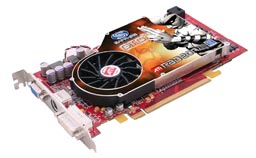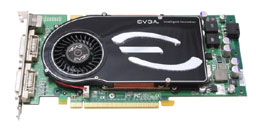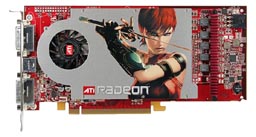Mid-Range to High-End Buyer's Guide, January 2006
by Jarred Walton on January 2, 2006 1:00 AM EST- Posted in
- Guides
Graphics Recommendations
All of the motherboards are obviously PCI Express systems, so we have mid-range and high-end recommendations. The problem is that we also get the NVIDIA vs. ATI perspective, and in many areas, there is no right answer. We prefer the SLI configurations to CrossFire configurations, as the pass-through cable just makes for increased cable clutter. Realistically, though, we feel most people are best served by getting a single graphics card within their budget constraints, so unless your budget is more than $700, we see no need to consider multiple GPUs. (Unless, of course, you're planning on running four displays from one system.)
Mid-Range Graphics Recommendation: eVGA GeForce 6800 GS 256MB
Price: $196 shipped (Retail)
Some people will say that even $200 is too much for a "Mid-Range" graphics card. If you really don't care about 3D performance, you can downgrade to just about any PCI Express graphics card and be happy. I look at recommendations within a price range, and $200 is a "Mid-Range" graphics card to me. It just so happens that there is a couple if good recommendations right at this price point, which helps justify the cost. The 6800 GS provides power roughly equal to last year's 6800 GT cards at a price about $100 lower. (Overclocking the cards can often come near 6800 Ultra performance levels, if you're interested in giving that a try.) Two of these cards end up being about equal to a 7800 GTX - faster in some instances and slower in others - so the upgrade potential is there. Honestly, though, we don't know how long the 6800 GS cards will be around, so plan on running one card and if you're looking to spend more than $200, upgrade to a faster single card.
Mid-Range Graphics Alternative: Sapphire Radeon X800GTO2 256MB
Price: $206 shipped (Retail)
And representing the red team, we have a similarly priced card in the form of the Sapphire X800 GTO2. Unlocking the full 16 pixel pipelines and overclocking the cores on these Sapphire cards has resulted in a very high success rate, though even at stock speeds, you get a very fast card. You miss out on SM3.0 support, which might become an issue in the future, but most of the SM3.0 enabled games seem to demand a bit more computational power than what last generation video cards can supply anyway. We don't like CrossFire for the X800 ATI platform for a number of reasons (1600x1200@60Hz is the big one), but as we've already mentioned, SLI/CF for sub-$700 GPU configurations doesn't make a lot of sense anyway. Like the 6800 GS, the X800 GTO/GTO2 cards may not be around much longer anyway. Still, X850 Pro (XT with overclocking) performance for $200 isn't a bad parting gift from ATI's R4xx series.
High-End Graphics Recommendation: eVGA 256-P2-N516 GeForce 7800GT 256MB
Price: $304 shipped (Retail)
The prices of 7800GT cards have dropped over $100 since launch, putting them below even most 6800 GT cards while providing more power than a 6800 Ultra. These cards can run almost any current game at resolutions up to 1920x1200, though you may have to tweak the detail levels a bit for optimal performance. The 6800 GT was an extremely popular card from NVIDIA last year, and the 7800 GT looks to surpass it in just about every area: lower street price, higher performance, better availability, and even slightly lower temperatures. At just over $300, this card strikes a great balance between price, performance, and features. High-end gamers can look towards the 7800 GTX 256MB and 512MB cards if they need even more power, and we would go that route before moving to SLI. Finding a 512MB GTX in stock is still difficult, unfortunately, though if you have $700 to blow it can be done.
High-End Graphics Alternative: Connect3D Radeon X1800XL 256MB
Price: $328 shipped (Retail)
Unlike the Mid-Range GPU recommendation, the ATI X1800XL is definitely an alternative as opposed to an equal recommendation to the 7800 GT. A higher price combined with generally slightly slower performance in our tests makes the NVIDIA card the winner. The SLI vs. CF comparison also favors the NVIDIA card, as you would need to buy a more expensive CF X1800 Master card for the X1800XL. Outside of the dual-GPU configurations, though, it's still relatively close, so those of you who inherently prefer ATI won't be missing out on much other than $25. Performance is very good in all current games with the X1800XL, and like the 7800 GT, prices have dropped over $100 since the cards first launched a couple of months ago. Looking to the higher-end ATI cards, ATI has the advantage. The X1800XT comes with 512MB of 1.5 GHz DDR3 memory, allowing it to surpass the 7800 GTX 256MB in the majority of tests. While the 7800 GTX 512MB does reign supreme as the fastest card, it also is very difficult to find, and the X1800XT is now readily available for about $495. It's definitely not cheap, but it's only $40 more than the cheapest GTX 256MB and usually more than 10% faster.
Graphics Recap
Given the number of choices for graphics, combined with the fact that needs can range from "just make Windows work" to "make FEAR run at 100 FPS!", we felt a quick rundown of the various price categories with a good recommendation for each was in order. That's what the above table represents, though we didn't go below the $100 price point for this level of system. The X1600 Pro from MSI represents an interesting value, which is good news. Although usually faster than the 6600GT and X700Pro, the X1600 appeared doomed for failure with the original MSRP of $200. A 500 MHz core with 12 pixel pipelines combined with 256MB of 800 MHz RAM for $134 is much more palatable, though, and it gets our recommendation for the lower cost mid-range or higher cost low-end graphics cards.
All of the motherboards are obviously PCI Express systems, so we have mid-range and high-end recommendations. The problem is that we also get the NVIDIA vs. ATI perspective, and in many areas, there is no right answer. We prefer the SLI configurations to CrossFire configurations, as the pass-through cable just makes for increased cable clutter. Realistically, though, we feel most people are best served by getting a single graphics card within their budget constraints, so unless your budget is more than $700, we see no need to consider multiple GPUs. (Unless, of course, you're planning on running four displays from one system.)
Mid-Range Graphics Recommendation: eVGA GeForce 6800 GS 256MB
Price: $196 shipped (Retail)
Some people will say that even $200 is too much for a "Mid-Range" graphics card. If you really don't care about 3D performance, you can downgrade to just about any PCI Express graphics card and be happy. I look at recommendations within a price range, and $200 is a "Mid-Range" graphics card to me. It just so happens that there is a couple if good recommendations right at this price point, which helps justify the cost. The 6800 GS provides power roughly equal to last year's 6800 GT cards at a price about $100 lower. (Overclocking the cards can often come near 6800 Ultra performance levels, if you're interested in giving that a try.) Two of these cards end up being about equal to a 7800 GTX - faster in some instances and slower in others - so the upgrade potential is there. Honestly, though, we don't know how long the 6800 GS cards will be around, so plan on running one card and if you're looking to spend more than $200, upgrade to a faster single card.
Mid-Range Graphics Alternative: Sapphire Radeon X800GTO2 256MB
Price: $206 shipped (Retail)
And representing the red team, we have a similarly priced card in the form of the Sapphire X800 GTO2. Unlocking the full 16 pixel pipelines and overclocking the cores on these Sapphire cards has resulted in a very high success rate, though even at stock speeds, you get a very fast card. You miss out on SM3.0 support, which might become an issue in the future, but most of the SM3.0 enabled games seem to demand a bit more computational power than what last generation video cards can supply anyway. We don't like CrossFire for the X800 ATI platform for a number of reasons (1600x1200@60Hz is the big one), but as we've already mentioned, SLI/CF for sub-$700 GPU configurations doesn't make a lot of sense anyway. Like the 6800 GS, the X800 GTO/GTO2 cards may not be around much longer anyway. Still, X850 Pro (XT with overclocking) performance for $200 isn't a bad parting gift from ATI's R4xx series.
High-End Graphics Recommendation: eVGA 256-P2-N516 GeForce 7800GT 256MB
Price: $304 shipped (Retail)
The prices of 7800GT cards have dropped over $100 since launch, putting them below even most 6800 GT cards while providing more power than a 6800 Ultra. These cards can run almost any current game at resolutions up to 1920x1200, though you may have to tweak the detail levels a bit for optimal performance. The 6800 GT was an extremely popular card from NVIDIA last year, and the 7800 GT looks to surpass it in just about every area: lower street price, higher performance, better availability, and even slightly lower temperatures. At just over $300, this card strikes a great balance between price, performance, and features. High-end gamers can look towards the 7800 GTX 256MB and 512MB cards if they need even more power, and we would go that route before moving to SLI. Finding a 512MB GTX in stock is still difficult, unfortunately, though if you have $700 to blow it can be done.
High-End Graphics Alternative: Connect3D Radeon X1800XL 256MB
Price: $328 shipped (Retail)
Unlike the Mid-Range GPU recommendation, the ATI X1800XL is definitely an alternative as opposed to an equal recommendation to the 7800 GT. A higher price combined with generally slightly slower performance in our tests makes the NVIDIA card the winner. The SLI vs. CF comparison also favors the NVIDIA card, as you would need to buy a more expensive CF X1800 Master card for the X1800XL. Outside of the dual-GPU configurations, though, it's still relatively close, so those of you who inherently prefer ATI won't be missing out on much other than $25. Performance is very good in all current games with the X1800XL, and like the 7800 GT, prices have dropped over $100 since the cards first launched a couple of months ago. Looking to the higher-end ATI cards, ATI has the advantage. The X1800XT comes with 512MB of 1.5 GHz DDR3 memory, allowing it to surpass the 7800 GTX 256MB in the majority of tests. While the 7800 GTX 512MB does reign supreme as the fastest card, it also is very difficult to find, and the X1800XT is now readily available for about $495. It's definitely not cheap, but it's only $40 more than the cheapest GTX 256MB and usually more than 10% faster.
Graphics Recap
| Graphics Cards | ||
| Class | Model | Price |
| Budget | Sapphire Radeon X700 Pro 128MB | 120 |
| Budget | MSI Radeon X1600 Pro 256MB | 134 |
| Budget | eVGA GeForce 6600GT 128MB | 140 |
| Mid-Range | eVGA GeForce 6800 GS 256MB | 196 |
| Mid-Range | Sapphire Radeon X800GTO2 256MB | 206 |
| High-End | eVGA 256-P2-N516 Geforce 7800GT 256MB | 304 |
| High-End | Connect3D Radeon X1800XL 256MB | 328 |
| Ultra-High | eVGA GeForce 7800GTX 256MB | 448 |
| Ultra-High | Sapphire Radeon X1800XT 512MB | 487 |
| Ultra-High | GeForce 7800GTX 512MB (Pre-Order) | 699 |
Given the number of choices for graphics, combined with the fact that needs can range from "just make Windows work" to "make FEAR run at 100 FPS!", we felt a quick rundown of the various price categories with a good recommendation for each was in order. That's what the above table represents, though we didn't go below the $100 price point for this level of system. The X1600 Pro from MSI represents an interesting value, which is good news. Although usually faster than the 6600GT and X700Pro, the X1600 appeared doomed for failure with the original MSRP of $200. A 500 MHz core with 12 pixel pipelines combined with 256MB of 800 MHz RAM for $134 is much more palatable, though, and it gets our recommendation for the lower cost mid-range or higher cost low-end graphics cards.














67 Comments
View All Comments
Yawgm0th - Monday, January 2, 2006 - link
Why restrict the display choices to LCDs that can't handle 1600x1200 and then complain about Crossfire only being able to support 1600x1200@60Hz. If you're willing to and would prefer to use an LCD, then how can you justify complaining about a shortcoming of Crossfire that can't possibly bother you?I'm not in favor of Crossfire or even opposed to LCDs (though I certainly prefer CRTs when mobility is not needed), but it would be nice to have some consistency.
JarredWalton - Monday, January 2, 2006 - link
As I suggested, Crossfire is a high-end option, and my high-end display choice is definitely going to want the new X1800 CF and not the X800 variant. I don't recommend SLI *or* Crossfire for a Mid-range system. I mean, $400-$500 gets you an X800 CF setup or a 6800GS SLI setup... or you can just get a single 7800GTX or X1800XT. Then you don't need to worry about CF/SLI profiles, improperly optimized games, etc. and you can always add a second card later if you change your mind.ImJacksAmygdala - Monday, January 2, 2006 - link
If I'm going to spend >$300 on a new monitor I atleast want it to be future proof with HDCP...JarredWalton - Monday, January 2, 2006 - link
THere is no way Microsoft or anyone else is going to force HDCP on us with Vista. Quick, name all the HDCP compliant displays out on the market. Um, there aren't any, at least outside of the HDTV world, right? MS knows that ALL of the market currently runs non-HDCP displays, so they would be completely insane to require everyone to buy a new monitor.DigitalFreak - Monday, January 2, 2006 - link
Wait a couple more weeks, and you can get the Dell 3007. 30" widescreen with specs comparable to the Apple 30" cinema display. No word on price yet, but I'm betting it will be quite a bit less than the Apple.JarredWalton - Monday, January 2, 2006 - link
There's also the 2407FPW coming out soon. I imagine the 30" display will be firmly in the "Dream" category, but I'm curious to see where the 2407 gets priced. It should be a bit cheaper than the 2405 to manufacture, but with higher specs it could still end up costing significantly more.Pythias - Monday, January 2, 2006 - link
I know you folks mean well, but cut the guy a little slack or else write your own guide.I believe the purpose of this article and its predecessors is to offer suggestions for people who have difficulty choosing components.
As Jarred said, This guide is not written in stone. Rather, it is merely a template subject to the individual's discretion.
tomchae - Monday, January 2, 2006 - link
these had the best feedback in newegg. are these good?-ABIT KN8 Ultra Socket 939 NVIDIA nForce4 Ultra ATX AMD Motherboard $99
http://www.newegg.com/Product/Product.asp?Item=N82...">http://www.newegg.com/Product/Product.asp?Item=N82...
-ASUS A8N-SLI Socket 939 NVIDIA nForce4 SLI ATX AMD Motherboard $122
http://www.newegg.com/Product/CustratingReview.asp...">http://www.newegg.com/Product/CustratingReview.asp...
bob661 - Monday, January 2, 2006 - link
I can definitely recommend the Asus board. Rock solid.JarredWalton - Tuesday, January 3, 2006 - link
Honestly, these days it's easier to come up with a short list of motherboards I *wouldn't* buy rather than ones that stand out as exceptional - and that goes double for socket 939 boards. There are very few boards out there that I would absolutely avoid. I just cut off my "alternative" list at a few boards from each price range; there are plenty of others (including ASUS, MSI, EPoX, Abit, etc.) that will work well.